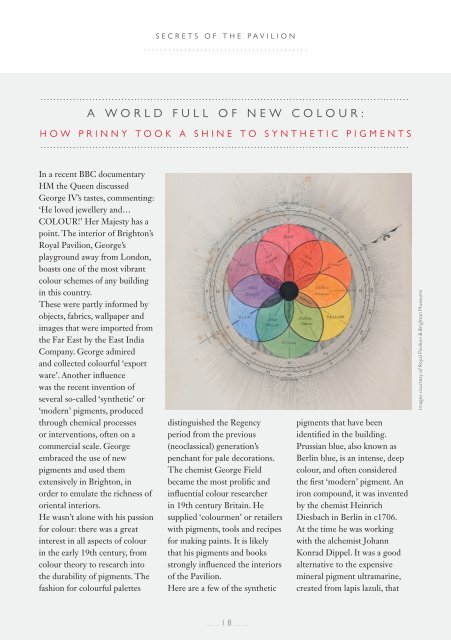Viva Brighton Issue #60 February 2018
You also want an ePaper? Increase the reach of your titles
YUMPU automatically turns print PDFs into web optimized ePapers that Google loves.
SECRETS OF THE PAVILION<br />
.........................................<br />
A WORLD FULL OF NEW COLOUR:<br />
HOW PRINNY TOOK A SHINE TO SYNTHETIC PIGMENTS<br />
In a recent BBC documentary<br />
HM the Queen discussed<br />
George IV’s tastes, commenting:<br />
‘He loved jewellery and…<br />
COLOUR!’ Her Majesty has a<br />
point. The interior of <strong>Brighton</strong>’s<br />
Royal Pavilion, George’s<br />
playground away from London,<br />
boasts one of the most vibrant<br />
colour schemes of any building<br />
in this country.<br />
These were partly informed by<br />
objects, fabrics, wallpaper and<br />
images that were imported from<br />
the Far East by the East India<br />
Company. George admired<br />
and collected colourful ‘export<br />
ware’. Another influence<br />
was the recent invention of<br />
several so-called ‘synthetic’ or<br />
‘modern’ pigments, produced<br />
through chemical processes<br />
or interventions, often on a<br />
commercial scale. George<br />
embraced the use of new<br />
pigments and used them<br />
extensively in <strong>Brighton</strong>, in<br />
order to emulate the richness of<br />
oriental interiors.<br />
He wasn’t alone with his passion<br />
for colour: there was a great<br />
interest in all aspects of colour<br />
in the early 19th century, from<br />
colour theory to research into<br />
the durability of pigments. The<br />
fashion for colourful palettes<br />
distinguished the Regency<br />
period from the previous<br />
(neoclassical) generation’s<br />
penchant for pale decorations.<br />
The chemist George Field<br />
became the most prolific and<br />
influential colour researcher<br />
in 19th century Britain. He<br />
supplied ‘colourmen’ or retailers<br />
with pigments, tools and recipes<br />
for making paints. It is likely<br />
that his pigments and books<br />
strongly influenced the interiors<br />
of the Pavilion.<br />
Here are a few of the synthetic<br />
pigments that have been<br />
identified in the building.<br />
Prussian blue, also known as<br />
Berlin blue, is an intense, deep<br />
colour, and often considered<br />
the first ‘modern’ pigment. An<br />
iron compound, it was invented<br />
by the chemist Heinrich<br />
Diesbach in Berlin in c1706.<br />
At the time he was working<br />
with the alchemist Johann<br />
Konrad Dippel. It was a good<br />
alternative to the expensive<br />
mineral pigment ultramarine,<br />
created from lapis lazuli, that<br />
Images courtesy of Royal Pavilion & <strong>Brighton</strong> Museums<br />
....18....


















